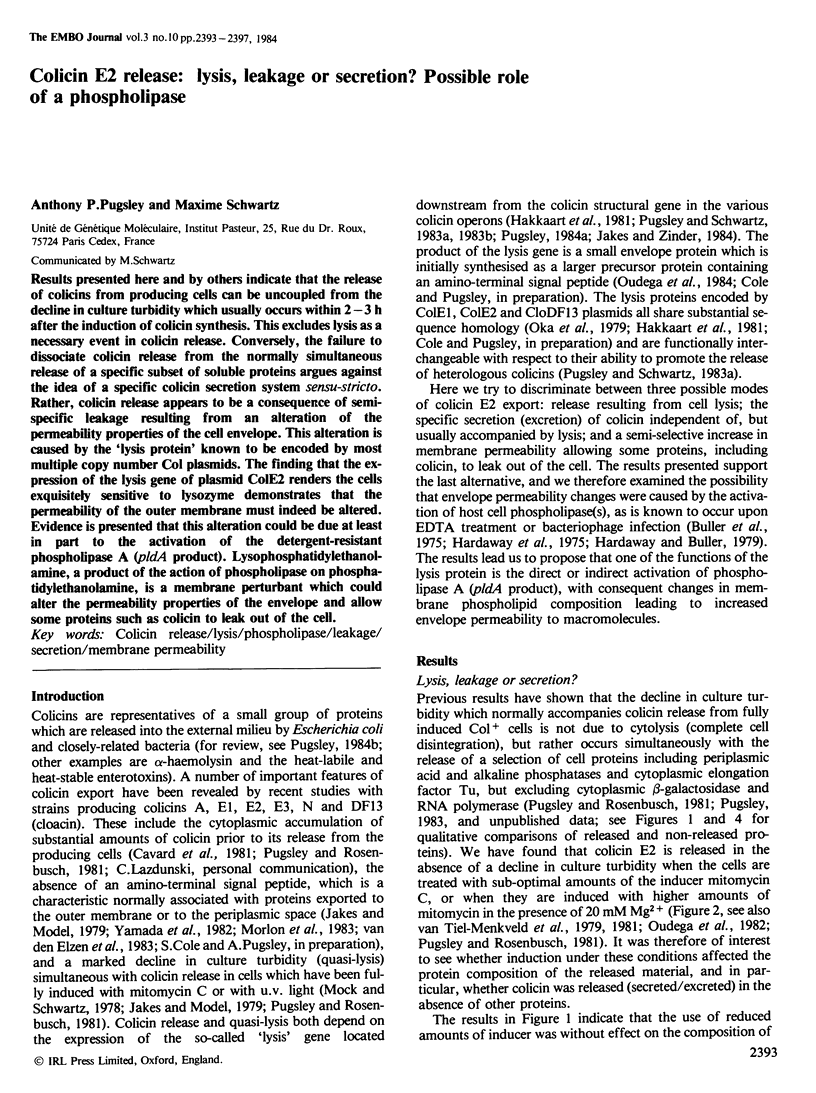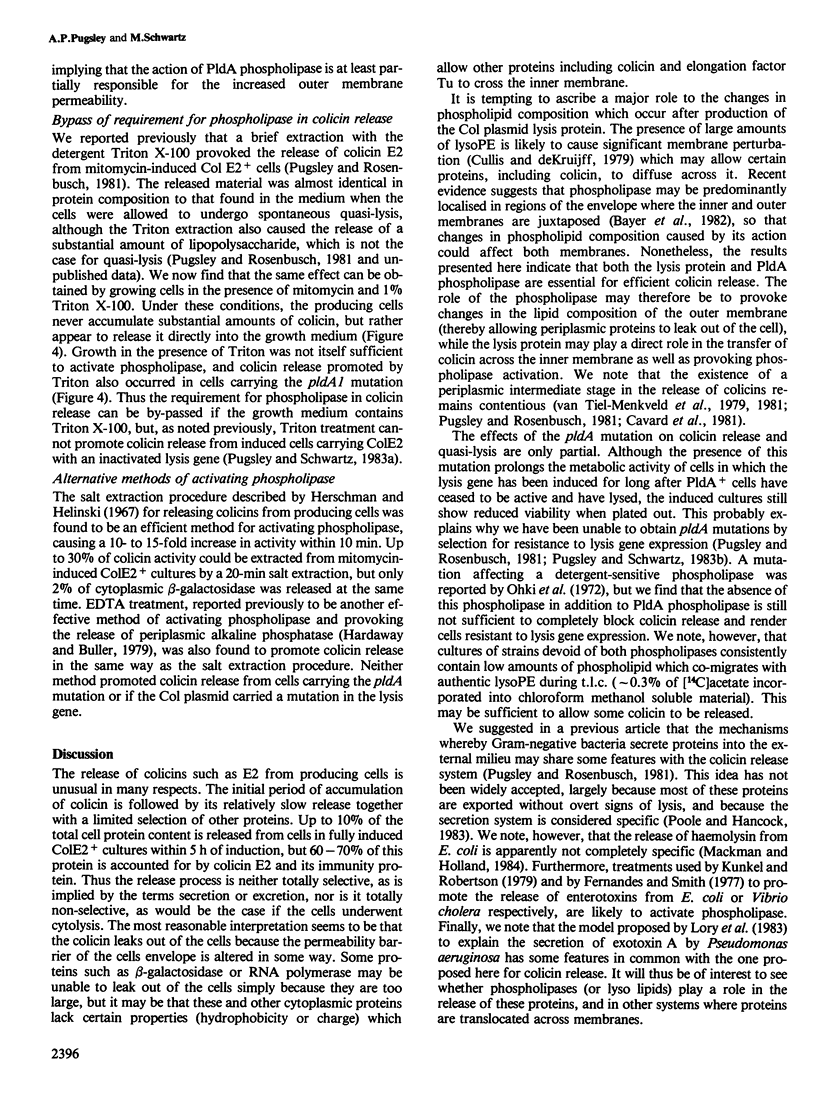Abstract
Results presented here and by others indicate that the release of colicins from producing cells can be uncoupled from the decline in culture turbidity which usually occurs within 2-3 h after the induction of colicin synthesis. This excludes lysis as a necessary event in colicin release. Conversely, the failure to dissociate colicin release from the normally simultaneous release of a specific subset of soluble proteins argues against the idea of a specific colicin secretion system sensu-stricto. Rather, colicin release appears to be a consequence of semi-specific leakage resulting from an alteration of the permeability properties of the cell envelope. This alteration is caused by the 'lysis protein' known to be encoded by most multiple copy number Col plasmids. The finding that the expression of the lysis gene of plasmid ColE2 renders the cells exquisitely sensitive to lysozyme demonstrates that the permeability of the outer membrane must indeed be altered. Evidence is presented that this alteration could be due at least in part to the activation of the detergent-resistant phospholipase A (pldA product). Lysophosphatidylethanolamine, a product of the action of phospholipase on phosphatidylethanolamine, is a membrane perturbant which could alter the permeability properties of the envelope and allow some proteins such as colicin to leak out of the cell.
Full text
PDF




Images in this article
Selected References
These references are in PubMed. This may not be the complete list of references from this article.
- Ames G. F. Lipids of Salmonella typhimurium and Escherichia coli: structure and metabolism. J Bacteriol. 1968 Mar;95(3):833–843. doi: 10.1128/jb.95.3.833-843.1968. [DOI] [PMC free article] [PubMed] [Google Scholar]
- Bayer M. H., Costello G. P., Bayer M. E. Isolation and partial characterization of membrane vesicles carrying markers of the membrane adhesion sites. J Bacteriol. 1982 Feb;149(2):758–767. doi: 10.1128/jb.149.2.758-767.1982. [DOI] [PMC free article] [PubMed] [Google Scholar]
- Buller C. S. Phospholipase activity in bacteriophage-infected Escherichia. II. Activation of phospholipase by T4 ghost infection. J Virol. 1975 May;15(5):1141–1147. doi: 10.1128/jvi.15.5.1141-1147.1975. [DOI] [PMC free article] [PubMed] [Google Scholar]
- Cavard D., Bernadac A., Lazdunski C. Exclusive localization of colicin A in cell cytoplasm of producing bacteria. Eur J Biochem. 1981 Sep;119(1):125–131. doi: 10.1111/j.1432-1033.1981.tb05585.x. [DOI] [PubMed] [Google Scholar]
- Cullis P. R., de Kruijff B. Lipid polymorphism and the functional roles of lipids in biological membranes. Biochim Biophys Acta. 1979 Dec 20;559(4):399–420. doi: 10.1016/0304-4157(79)90012-1. [DOI] [PubMed] [Google Scholar]
- Dente L., Cesareni G., Cortese R. pEMBL: a new family of single stranded plasmids. Nucleic Acids Res. 1983 Mar 25;11(6):1645–1655. doi: 10.1093/nar/11.6.1645. [DOI] [PMC free article] [PubMed] [Google Scholar]
- Fernandes P. B., Smith H. L., Jr The effect of anaerobiosis and bile salts on the growth and toxin production by Vibrio cholerae. J Gen Microbiol. 1977 Jan;98(1):77–86. doi: 10.1099/00221287-98-1-77. [DOI] [PubMed] [Google Scholar]
- Hakkaart M. J., Veltkamp E., Nijkamp H. J. Protein H encoded by plasmid Clo DF13 involved in lysis of the bacterial host. I. Localisation of the gene and identification and subcellular localisation of the gene H product. Mol Gen Genet. 1981;183(2):318–325. doi: 10.1007/BF00270635. [DOI] [PubMed] [Google Scholar]
- Hardaway K. L., Buller C. S. Effect of ethylenediaminetetraacetate on phospholipids and outer membrane function in Escherichia coli. J Bacteriol. 1979 Jan;137(1):62–68. doi: 10.1128/jb.137.1.62-68.1979. [DOI] [PMC free article] [PubMed] [Google Scholar]
- Hardaway K. L., Maten M. V., Buller C. S. Phospholipase activity in bacteriophage-infected Escherichia coli. III. Phopholipase A involvement in lysis of T4-infected cells. J Virol. 1975 Oct;16(4):867–871. doi: 10.1128/jvi.16.4.867-871.1975. [DOI] [PMC free article] [PubMed] [Google Scholar]
- Herschman H. R., Helinski D. R. Purification and characterization of colicin E2 and colicin E3. J Biol Chem. 1967 Nov 25;242(22):5360–5368. [PubMed] [Google Scholar]
- Iyobe S., Sagai H., Mitsuhashi S. Tn2001, a transposon encoding chloramphenicol resistance in Pseudomonas aeruginosa. J Bacteriol. 1981 Apr;146(1):141–148. doi: 10.1128/jb.146.1.141-148.1981. [DOI] [PMC free article] [PubMed] [Google Scholar]
- Jakes K. S., Model P. Mechanism of export of colicin E1 and colicin E3. J Bacteriol. 1979 Jun;138(3):770–778. doi: 10.1128/jb.138.3.770-778.1979. [DOI] [PMC free article] [PubMed] [Google Scholar]
- Jakes K. S., Zinder N. D. Plasmid ColE3 specifies a lysis protein. J Bacteriol. 1984 Feb;157(2):582–590. doi: 10.1128/jb.157.2.582-590.1984. [DOI] [PMC free article] [PubMed] [Google Scholar]
- Kunkel S. L., Robertson D. C. Factors affecting release of heat-labile enterotoxin by enterotoxigenic Escherichia coli. Infect Immun. 1979 Mar;23(3):652–659. doi: 10.1128/iai.23.3.652-659.1979. [DOI] [PMC free article] [PubMed] [Google Scholar]
- Lory S., Tai P. C., Davis B. D. Mechanism of protein excretion by gram-negative bacteria: Pseudomonas aeruginosa exotoxin A. J Bacteriol. 1983 Nov;156(2):695–702. doi: 10.1128/jb.156.2.695-702.1983. [DOI] [PMC free article] [PubMed] [Google Scholar]
- Mackman N., Holland I. B. Secretion of a 107 K dalton polypeptide into the medium from a haemolytic E. coli K12 strain. Mol Gen Genet. 1984;193(2):312–315. doi: 10.1007/BF00330686. [DOI] [PubMed] [Google Scholar]
- Mock M., Schwartz M. Mechanism of colicin E3 production in strains harboring wild-type or mutant plasmids. J Bacteriol. 1978 Nov;136(2):700–707. doi: 10.1128/jb.136.2.700-707.1978. [DOI] [PMC free article] [PubMed] [Google Scholar]
- Morlon J., Lloubès R., Varenne S., Chartier M., Lazdunski C. Complete nucleotide sequence of the structural gene for colicin A, a gene translated at non-uniform rate. J Mol Biol. 1983 Oct 25;170(2):271–285. doi: 10.1016/s0022-2836(83)80148-x. [DOI] [PubMed] [Google Scholar]
- Nishijima M., Nakaike S., Tamori Y., Nojima S. Detergent-resistant phospholipase A of Escherichia coli K-12. Purification and properties. Eur J Biochem. 1977 Feb 15;73(1):115–124. doi: 10.1111/j.1432-1033.1977.tb11297.x. [DOI] [PubMed] [Google Scholar]
- Oka A., Nomura N., Morita M., Sugisaki H., Sugimoto K., Takanami M. Nucleotide sequence of small ColE1 derivatives: structure of the regions essential for autonomous replication and colicin E1 immunity. Mol Gen Genet. 1979 May 4;172(2):151–159. doi: 10.1007/BF00268276. [DOI] [PubMed] [Google Scholar]
- Oki M., Doi O., Nojima S. Mutant of Escherichia coli K-12 deficient for detergent-resistant phospholipase A. J Bacteriol. 1972 Jun;110(3):864–869. doi: 10.1128/jb.110.3.864-869.1972. [DOI] [PMC free article] [PubMed] [Google Scholar]
- Oudega B., Stegehuis F., van Tiel-Menkveld G. J., de Graaf F. K. Protein H encoded by plasmid CloDF13 is involved in excretion of cloacin DF13. J Bacteriol. 1982 Jun;150(3):1115–1121. doi: 10.1128/jb.150.3.1115-1121.1982. [DOI] [PMC free article] [PubMed] [Google Scholar]
- Pugsley A. P. Genetic analysis of ColN plasmid determinants for colicin production, release, and immunity. J Bacteriol. 1984 May;158(2):523–529. doi: 10.1128/jb.158.2.523-529.1984. [DOI] [PMC free article] [PubMed] [Google Scholar]
- Pugsley A. P. Obligatory coupling of colicin release and lysis in mitomycin-treated Col+ Escherichia coli. J Gen Microbiol. 1983 Jun;129(6):1921–1928. doi: 10.1099/00221287-129-6-1921. [DOI] [PubMed] [Google Scholar]
- Pugsley A. P., Rosenbusch J. P. Release of colicin E2 from Escherichia coli. J Bacteriol. 1981 Jul;147(1):186–192. doi: 10.1128/jb.147.1.186-192.1981. [DOI] [PMC free article] [PubMed] [Google Scholar]
- Pugsley A. P., Schwartz M. A genetic approach to the study of mitomycin-induced lysis of Escherichia coli K-12 strains which produce colicin E2. Mol Gen Genet. 1983;190(3):366–372. doi: 10.1007/BF00331060. [DOI] [PubMed] [Google Scholar]
- Pugsley A. P., Schwartz M. Expression of a gene in a 400-base-pair fragment of colicin plasmid ColE2-P9 is sufficient to cause host cell lysis. J Bacteriol. 1983 Oct;156(1):109–114. doi: 10.1128/jb.156.1.109-114.1983. [DOI] [PMC free article] [PubMed] [Google Scholar]
- Scandella C. J., Kornberg A. A membrane-bound phospholipase A1 purified from Escherichia coli. Biochemistry. 1971 Nov 23;10(24):4447–4456. doi: 10.1021/bi00800a015. [DOI] [PubMed] [Google Scholar]
- Van Tiel-Menkvled G. J., Rezee A., De Graaf F. K. Production and excretion of cloacin DF13 by Escherichia coli harboring plasmid CloDF13. J Bacteriol. 1979 Nov;140(2):415–423. doi: 10.1128/jb.140.2.415-423.1979. [DOI] [PMC free article] [PubMed] [Google Scholar]
- Yamada M., Ebina Y., Miyata T., Nakazawa T., Nakazawa A. Nucleotide sequence of the structural gene for colicin E1 and predicted structure of the protein. Proc Natl Acad Sci U S A. 1982 May;79(9):2827–2831. doi: 10.1073/pnas.79.9.2827. [DOI] [PMC free article] [PubMed] [Google Scholar]
- de Geus P., van Die I., Bergmans H., Tommassen J., de Haas G. Molecular cloning of pldA, the structural gene for outer membrane phospholipase of E. coli K12. Mol Gen Genet. 1983;190(1):150–155. doi: 10.1007/BF00330338. [DOI] [PubMed] [Google Scholar]
- van den Elzen P. J., Walters H. H., Veltkamp E., Nijkamp H. J. Molecular structure and function of the bacteriocin gene and bacteriocin protein of plasmid Clo DF13. Nucleic Acids Res. 1983 Apr 25;11(8):2465–2477. doi: 10.1093/nar/11.8.2465. [DOI] [PMC free article] [PubMed] [Google Scholar]




